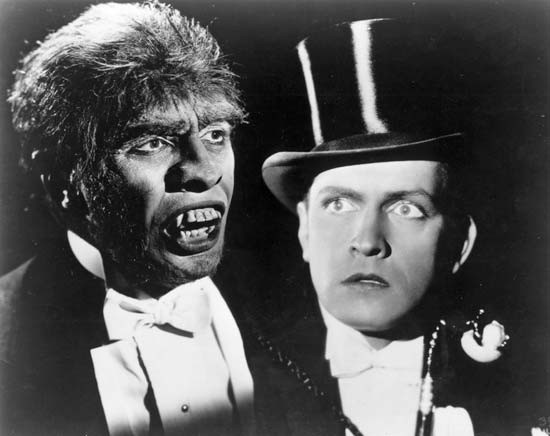Jekyll and Hyde TV show attacked for 'brutal and graphic scenes'

Complaints to Ofcom rose to 742 after the first episode of Jekyll and Hyde, due to scenes of murder, torture and an assortment of terrifying monsters. Writer Charlie Higson defended the show in a series of Twitter messages: "Seems to be a veritable twitterstorm of tweets in support of #JekyllandHyde telling scaredy cats to grow up and get with the modern world."
The show was criticised by Claude Knights, of child protection charity Kidscape. "Concerns regarding the showing of brutal and graphic scenes long before the watershed do not point to the overprotection of children by parents out of tune with the modern world."
The second episode which airs on Sunday 1 November keeps up the gore content, opening with a teenager lying on the floor, his head pouring with blood as he hears his parents being killed. He is then attacked by a terrifying creature.
Jekyll and Hyde features monsters throughout the series, with spooky creatures including ghouls, zombies, werewolves and vampires. Foz Allan, the series director, said: "The idea that monsters are with us is universal. Everywhere has them. They've defined the world for so long and I don't think they're going away. They're there in the shadows.
"We have all sorts of strange monsters. A mixture of make-up, prosthetics, costume and CGI. We have The Harbinger, who has a man's head and a dog's body. We have The Cutter who is seven foot tall with a lobster clawed hand. We have upside down face lady. We have living skeletons – an army of the dead."

Ghouls gallery
- The Vetala: The zombie-like reanimated corpses of Captain Dance's enemies, they become his ghoulish slaves.
- The Harbinger: Half man, half dog, he brings dire warnings of the future.
- The Black Dog: When under pressure Robert turns into Hyde. During the series he meets a branch of his family who when under similar pressure turn into monstrous black dogs.
- The Cutter: 7'6" tall and with a lobster claw for an arm. He may not be very bright but he's extremely destructive.
- The Moroii: Hideous leech-like creatures who help Captain Dance to regenerate, but when let loose into the sewers they grow to monstrous proportions.
- The Reaper Bug: A parasite that gets inside you and controls your every action.
- The Incubus: A demon who takes on the form of the person you love most in the world in order to eat your soul.
Tom Bateman who plays the characters of Robert Jekyll and his evil apparition Hyde, believes he has experienced supernatural phenomena. "When I was 16 or 17 I was doing some work with the father of my girlfriend at the time. He was an archaeologist and we were working and camping in the fields. I was in a tent in the middle of the night when suddenly this bright light appeared.
"I thought it was a helicopter but it was absolutely silent. I stuck my head out of the tent, blinded by this light with no noise at all. And then it just disappeared. And we were in the middle of a field. I woke up in the morning and thought: 'That was weird. I definitely didn't dream that.'"
Richard E Grant plays plays Bulstrode who heads the secret government of department MI0 explains the enduring appeal of Jekyll and Hyde. "Every day in the newspapers you will read about somebody who has said: 'We had no idea he was like that.' People can seem perfectly normal and you find out they are not. It's that. You think you know people and you don't really know anything."
The story behind the story
The ITV show is based on the Strange Case of Dr Jekyll and Mr Hyde, which is the original title of a novella written by the Scottish author Robert Louis Stevenson that was first published in 1886. The theme of the book is concerned with the mental condition often called "split personality", referred to in psychiatry as dissociative identity disorder.
In an earlier draft of the book, Stevenson deleted details such as the sexual connotations of Jekyll, taking out the phrase: "From an early age, however, I became in secret the slave of certain appetites."
Many believe that the inspiration behind Jekyll and Hyde was Deacon Brodie, who lived a secret life as a burglar. He was hanged for his crimes in 1788 before a crowd of 40,000. Stevenson's father owned furniture made by Brodie, and he wrote a play entitled Deacon Brodie, or The Double Life while still a teenager.
Stevenson was obsessed by the idea of how personalities can affect a human and how to incorporate the interplay of good and evil into a story. A number of biographers have alleged that Stevenson was taking drugs while writing the novel. In William Gray's history A Literary Life (2004) he claims that Stevenson was using cocaine, while other biographers said he used ergot, a mushroom containing lysergic acid which is a percursor to the hallucinogenc drug LSD.
More about Jekyll and Hyde
Jekyll and Hyde Transgender Woman Puts Male Alter Ego in Frame for Triple Prostitute Murders
Analysis: SNP's Jekyll and Hyde Arguments on Scottish Independence
© Copyright IBTimes 2025. All rights reserved.






















